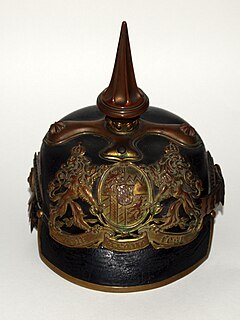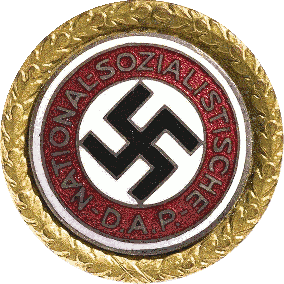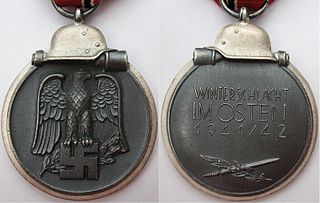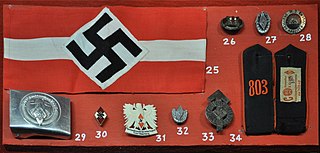
The Pickelhaube, also Pickelhelm, is a spiked helmet worn in the 19th and 20th centuries by Prussian and German military, firefighters and police. Although typically associated with the Prussian Army, which adopted it in 1842–43, the helmet was widely imitated by other armies during that period. It is still worn today as part of ceremonial wear in the militaries of certain countries, such as Sweden, Chile, and Colombia.

Der Stahlhelm, Bund der Frontsoldaten, commonly known as Der Stahlhelm, was a German First World War veteran's organisation existing from 1918 to 1935. It was part of the "Black Reichswehr" and in the late days of the Weimar Republic operated as the paramilitary wing of the Monarchist German National People's Party (DNVP), placed at party gatherings in the position of armed security guards (Saalschutz).
Awards and Decorations of Nazi Germany were military, political and civilian decorations that were bestowed between 1923 and 1945, first by the Nazi Party and later the state of Nazi Germany.
Paramilitary groups were formed throughout the Weimar Republic in the wake of Germany's defeat in World War I and the ensuing German Revolution. Some were created by political parties to help in recruiting, discipline and in preparation for seizing power. Some were created before World War I. Others were formed by individuals after the war and were called "Freikorps". The party affiliated groups and others were all outside government control, but the Freikorps units were under government control, supply and pay.

The Stahlhelm is a specific type of German military headgear made of steel, which is primarily intended to provide protection against shrapnel and fragments of grenades. The term Stahlhelm refers both to a generic steel helmet, and more specifically to the distinctive German military design.

Theodor Duesterberg was a leader of Der Stahlhelm in Germany prior to the Nazi seizure of power.

The Blood Order, officially known as the Decoration in Memory of 9 November 1923, was one of the most prestigious decorations in the Nazi Party (NSDAP). During March 1934, Hitler authorized the Blood Order to commemorate the 9 November 1923 coup attempt of the Nazi Party. The medal is silver, with the obverse bearing a depiction of an eagle grasping an oakleaf wreath. Inside the wreath is the date 9.Nov. and to the right is the inscription München 1923–1933. The reverse shows the entrance of the Feldherrnhalle in relief, and directly above is the angled swastika with sun rays in the background. Along the top edge is the inscription: UND IHR HABT DOCH GESIEGT.

The Golden Party Badge was authorised by Adolf Hitler in a decree in October 1933. It was a special award given to all Nazi Party members who had, as of 9 November 1933, registered numbers from 1 to 100,000 and unbroken Party membership. The recipient's party number was inscribed on the reverse of the badge. Only 20,487 men and 1,795 women were awarded the badge on these terms.

The Wound Badge was a German military decoration first promulgated by Wilhelm II, German Emperor on 3 March 1918, which was awarded to soldiers of the German Army who were wounded during World War I. Between the world wars, it was awarded to members of the German armed forces who fought on the Nationalist side of the Spanish Civil War, 1938–39, and received combat related wounds. It was awarded to members in the Reichswehr, the Wehrmacht, SS and the auxiliary service organizations during World War II. After March 1943, due to the increasing number of Allied bombings, it was also awarded to civilians wounded in air raids. It was awarded when the wound was the result of enemy hostile action.

The Eastern Medal, officially the Winter Battle in the East 1941–42 Medal, was a military award of the Wehrmacht which was created by ordinance of Adolf Hitler on 26 May 1942.

Franz Seldte was a German politician who served as the Reich Minister for Labour from 1933 to 1945. Prior to his ministry, Seldte served as the Federal Leader of Der Stahlhelm World War I ex-servicemen's organisation from 1918 to 1934. Ideologically, he identified as a national conservative.

Political decorations of the Nazi Party were medals and awards issued by the National Socialist German Workers Party (NSDAP) between 1920 and 1945. Political awards were authorized for wear on any paramilitary uniform of Nazi Germany, as well as civilian attire, but were generally discouraged on Wehrmacht military uniforms. The Waffen-SS freely wore both political awards and military decorations on their uniforms.

The hełm wz. 31 was the basic combat helmet of the Polish Army before the outbreak of World War II and during the Invasion of Poland. The helmet became the basic type of combat headgear for Polish military formations in 1930s and during the early stages of World War II. It was also exported to Persia, Albania and Republican Spain. By September 1939 approximately 320,000 copies were delivered to the Polish Army.
Volker Rolf Berghahn is a historian of German and modern European history at Columbia University. His research interests have included the fin de siècle period in Europe, the origins of World War I, and German-American relations. He received his M.A. from the University of North Carolina at Chapel Hill in 1961 and his Ph.D., under supervision of Francis L. Carsten, from the University of London in 1964. Prior to teaching in the United States, Berghahn worked in the United Kingdom and Germany. In 1988, he accepted a position at Brown University, and moved to Columbia ten years later.

The Reichsbanner Schwarz-Rot-Gold was an organization in Germany during the Weimar Republic, formed by members of the Social Democratic Party of Germany, the German Centre Party, and the (liberal) German Democratic Party in February 1924. Its goal was to defend parliamentary democracy against internal subversion and extremism from the left and right, to teach the population to respect the new Republic, to honor its flag and the constitution. Its name is derived from the Flag of Germany adopted in 1919, the colors of which were associated with liberal parliamentary democracy and the republic, and themselves had first appeared together on a state flag, within a German-ethnicity sovereign state in 1778.
Franz Breithaupt was a German SS functionary during the Nazi era. From August 1942 until April 1945, he was chief of the SS Court Main Office (Hauptamt SS-Gericht). Breithaupt was murdered by his SS aide Karl Lang just prior to the end of the war in Europe.

The Wehrmacht Long Service Award was a military service decoration of Nazi Germany issued for satisfactory completion of a number of years in military service.

The Hitler Youth Badge was a political decoration of Nazi Germany, awarded for various degrees of service to the Hitler Youth, (Hitler Jugend). The badge was first created in 1929, with formal regulations for presentation as a decoration formalized from 1933. In addition, the Hitler Youth introduced a number of other awards for merit and proficiency.

The SS Chevron for Former Police and Military was a prior service qualification badge worn by members of the Nazi Party Schutzstaffel (SS) who had previously served as professional law enforcement, as members of the Reichswehr or members of Der Stahlhelm, Bund der Frontsoldaten.
An estimated 100,000 German Jewish military personnel served in the German Army during World War I, of whom 12,000 were killed in action. The Iron Cross was awarded to 18,000 German Jews during the war.















